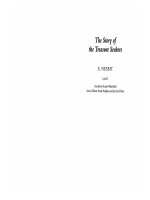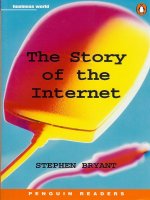4 1 1 the story of libraries (social studies)
Bạn đang xem bản rút gọn của tài liệu. Xem và tải ngay bản đầy đủ của tài liệu tại đây (4.71 MB, 14 trang )
Suggested levels for Guided Reading, DRA,™
Lexile,® and Reading Recovery™ are provided
in the Pearson Scott Foresman Leveling Guide.
The
Story
of
Libraries
by Seth Williams
Genre
Expository
nonfiction
Comprehension
Skills and Strategy
• Sequence
• Main Idea and
Details
• Summarize
Text Features
•
•
•
•
Captions
Heads
Labels
Glossary
Scott Foresman Reading Street 4.1.1
ISBN 0-328-13414-7
ì<(sk$m)=bdebe < +^-Ä-U-Ä-U
Reader Response
1. Using a chart similar to the one below, put the
following events in the order in which they
happened: Trajan’s library founded; clay tablets
created near Nippur; movable type invented by
Gutenberg; Royal Library at Alexandria founded.
The
First
Next
Then
Story
of
Libraries
Li
braries
Last
2. How would you summarize the major events in
the life of Andrew Carnegie? Use pages 14–19.
3. Use a thesaurus. Make a ladder of synonyms for
the word peculiar. Rank the synonyms from most
peculiar (top) to least peculiar (bottom).
by Seth Williams
4. Look at the picture on page 6. How is the Royal
Library different from the library at your school or
in your town?
Editorial Offices: Glenview, Illinois • Parsippany, New Jersey • New York, New York
Sales Offices: Needham, Massachusetts • Duluth, Georgia • Glenview, Illinois
Coppell, Texas • Ontario, California • Mesa, Arizona
Around 650 B. C. in ancient Assyria, King
Ashurbanipal had just won a war against Babylon.
Prideful of his place in history, the king took
valuable clay tablets from Babylon and added them
to his library in Nineveh. In one of the tablets, the
king left a message saying that anyone who broke,
harmed, or removed the tablet and replaced it would
be cursed by the gods.
There was nothing peculiar about the king’s
threat. Books in the ancient world were valuable
because of the information they contained. Then, as
it is now, knowledge was power. The information in
a book could be as powerful as an army.
Every effort has been made to secure permission and provide appropriate credit for
photographic material. The publisher deeply regrets any omission and pledges to
correct errors called to its attention in subsequent editions.
Unless otherwise acknowledged, all photographs are the property of Scott Foresman,
a division of Pearson Education.
Photo locators denoted as follows: Top (T), Center (C), Bottom (B), Left (L), Right (R),
Background (Bkgd)
Opener: (Bkgd) Bettmann/Corbis, (C) Brand X Pictures; 1 Brand X Pictures;
3 (BL, BR) Brand X Pictures; 4 Erich Lessing/Art Resource, NY; 5 Getty Images;
6 Bettmann/Corbis; 7 Brand X Pictures; 8 The Pierpont Morgan Library/Art Resource,
NY; 9 North Wind Picture Archives; 11 (BR) Brand X Pictures, (C) Library of Congress;
12 Lee Snider/Photo Images/Corbis; 13 Corbis; 14 The Granger Collection, NY;
17 Library of Congress; 18 Henny Abrams/Corbis; 19 Getty Images; 20 (C) Alessandro
Gandolfi/Index Stock Imagery, (BR) Sandro Vannini/Corbis; 21 Sandro Vannini/Corbis;
22 Corbis; 23 Brand X Pictures
ISBN: 0-328-13414-7
Copyright © Pearson Education, Inc.
All Rights Reserved. Printed in the United States of America. This publication is
protected by Copyright, and permission should be obtained from the publisher
prior to any prohibited reproduction, storage in a retrieval system, or transmission
in any form by any means, electronic, mechanical, photocopying, recording, or
likewise. For information regarding permission(s), write to: Permissions Department,
Scott Foresman, 1900 East Lake Avenue, Glenview, Illinois 60025.
2 3 4 5 6 7 8 9 10 V0G1 14 13 12 11 10 09 08 07 06 05
Early and modern forms
of written communication
3
Early Libraries and the Written Word
The word library comes from liber, the Latin
word for “book.” The first books were written by
hand on rolls of paperlike material, papyrus, around
3000 B.C. Other early books were handwritten on
clay tablets from around the same time. Among
the first libraries, or record rooms, was a group of
tablets dating to around 2300 B.C. that was found
near Nippur in Mesopotamia. The tablets listed
geographical names, gods, names of professions, and
a number of religious hymns.
Tablet writing from
around 3000 B.C.
4
It was the Greeks who developed libraries with
books on all subjects available to all readers. But it
was not easy. The Dark Age of ancient Greece took
place from 1200 B.C. to 900 B.C. During this time cities
were destroyed and the knowledge of how to write
was lost. Fortunately the Phoenicians, who lived in
present-day Lebanon and Israel, had developed a
form of writing that was fairly simple to learn. The
Greeks adapted letters from this alphabet to make
their own alphabet.
By the 400s B.C. the Greeks also had created a
way to teach people about different subjects. Poetry
and religious works were written down, as well as
works in history, art, and even cooking.
Ancient Greek ruins
5
The Royal Library at Alexandria
The greatest center of ancient civilization in the
Middle East was Egypt, home of the famous Royal
Library at Alexandria. Founded around 300 B.C. by
the Greek king Ptolemy I, it lasted for nearly six
hundred years. It was the first library to offer a
wide variety of books. It had about half a million
handwritten rolls, or scrolls.
The Royal Library at Alexandria
We know this because one man, Callimachus,
put together an index of the entire library’s writings
telling about each piece of work. His index filled
120 books! Sadly, any writer who hoped that the one
copy of his book in the Royal Library at Alexandria
would be a permanent memorial tribute to him
would be disappointed. The library is thought to
have been destroyed during a civil war in Alexandria
around A.D. 270.
The Library at Alexandria was a great
success in its time. The library and its
contents were built from scratch. Books
from other cultures were brought to the
library. The kings would bring great
thinkers of the day to the library to
meet, study, and give
speeches. These people
were housed, fed, and paid
to live there.
A scroll
6
7
More Libraries and Learning
Other libraries were built during the Roman
Empire, a time when Rome was trying to take over
other lands. Julius Caesar planned a grand library
that would have both Greek and Latin sections,
but he did not live to see it through. The emperor
Trajan’s library was established in A.D. 114. It was
one of the most famous Roman libraries. It held
about twenty thousand scrolls.
The fall of the Roman Empire in A.D. 476
also marked the end of its libraries. Yet libraries
continued to flourish in the East, especially in Syria
and Persia. The followers of the prophet Muhammad,
the founder of the Islamic religion, preserved the
libraries of those they conquered. Starting in the 600s,
they translated the books they found into Arabic.
By the end of the 700s, Baghdad was a world
center of learning. From the Chinese, Arabs learned
the art of making paper from linen or cotton rags.
They adopted the form of the codex to replace the
scroll. This changed the book into the basic shape
we know today. Copying and translating books
preserved many that might have been lost forever
during the Dark Ages of Europe.
8
The printing press was invented by a German
printer named Johannes Gutenberg in the mid-1400s.
Books were then printed rather than written by
hand. As public libraries started to be built, wealthy
nobles usually provided books and money. By the
end of the 1500s there were libraries in almost every
major European city, and many were open to the
public. Valuable books were sometimes fastened to
bookshelves with long chains to keep them from
being stolen.
Gutenberg’s
printing press
9
Libraries in Early America
The earliest settlers of the American colonies
brought some books with them, mainly for religious
reasons. The wealthiest merchants and planters may
have had their own libraries, but most people who
could read probably only read the Bible. During
the 1700s, as ways to print books improved, more
people could afford to buy them, but books were
still too expensive for most people.
In 1727, when Ben Franklin was a young printer
in Philadelphia, he formed the Junto. It was a
debate, or discussion, club. The group met once a
week. They hoped to educate each other and make
up for the fact that many of them could not afford to
go to college.
The members of the club were interested in
learning just for the sake of learning. They debated
questions such as whether one form of government
is best for everyone. Every three months, each
member had to write an essay and read it to the
whole group.
Benjamin Franklin
sits at a desk during
a meeting.
10
11
A few years later, the Second Continental
Congress met in Philadelphia to write the Declaration
of Independence. Nine signers of the Declaration
were also members of the Library Company. In fewer
than fifty years, with over two thousand books and
hundreds of subscribers, the Library Company had
come a long way from Ben Franklin’s small debate
club. In fact, the Library Company still exists today.
The idea of independent libraries eventually
spread throughout the colonies and, later, the young
United States. The Providence Athenaeum, in Rhode
Island, was founded in 1753, and the New York
Society Library was founded in 1754. In Philadelphia,
the Union Library, which itself had been formed
from two smaller libraries in 1746, merged with the
Library Company in 1769.
A statue of Benjamin Franklin stands
above the front door of a reconstruction
of the Library Company in Philadelphia.
Not everyone in the group could afford to have
his own personal library of books to read to prepare
these essays. So Ben Franklin suggested that the
group put their earnings together and buy books
that the members could borrow. In 1731 the Library
Company became the first lending library in America.
Fifty people gave money to the Library Company
to keep it running. By 1741 the library listed 375
titles in its catalogue. Members could borrow books
without charge. Non-members had to leave a security
deposit equal to the value of the book borrowed.
The Boston Athenaeum, founded in 1807
12
13
Carnegie the Great
In 1835, forty-five years after Ben Franklin’s
death, Andrew Carnegie was born to a poor family
of weavers in Scotland. Andrew grew up in a small
stone house with a younger brother, Tom. His
father, Will, weaved at his hand loom on the ground
floor. Andrew’s mother, Margaret, became a skilled
shoemaker. Andrew enjoyed being at home with
his parents so much that he was not positive he
wanted to go to school. He found life in his small
town interesting. Andrew enjoyed hearing stories of
Scottish history from his uncle, George Lauder, who
ran a local grocery store.
When he was supposed to begin school at the
age of five, Andrew refused to go. His parents
allowed him to wait until he was ready, but after
three years they were concerned. They asked their
local schoolmaster to convince Andrew that school
was exciting.
Finally when he was eight years old, Andrew
started attending school. There were 150 children of
all ages in one big classroom. Though he attended
school for only five years, young Andrew was an
ambitious and bright student. He especially loved to
memorize poetry.
As Andrew grew up, his father could not continue
to support his family by weaving. Steam-powered
machinery was beginning to replace hand looms.
Soon work became harder and harder for Will
Carnegie to find. Machine-woven textiles were here
to stay. Will was very discouraged, but Margaret
had an idea. Two of her sisters had already moved
to America to seek a better life. So in 1848, the
Carnegie family did the same. They left Scotland
for the United States and settled in what is now
Pittsburgh, Pennsylvania.
Andrew Carnegie
as a young man
14
15
A Working Boy
Andrew worked in cotton mills, and he was able
to work his way up to billing clerk and messenger.
After a while he got a job in a telegraph office as
a messenger. Soon he was supervising the other
messengers, which gave him a little extra time
to learn how to operate the telegraph machine.
Using the telegraph, one could send messages over
telegraph wires. The messages were sent in an
instant through a system of dots and dashes called
Morse code, named after its inventor, Samuel F. B.
Morse. Once Andrew learned to translate Morse code
he became a telegraph operator.
Andrew also enjoyed skating on the river and
discussing current events with his young friends. He,
too, formed a debate club. Despite the efforts of Ben
Franklin and others, there were still very few books
available for borrowing in the Pittsburgh area. There
was no public library either.
One day Andrew was reading the newspaper.
Colonel James Anderson, a wealthy local resident,
was opening his four hundred volume personal
library on Saturday afternoons to young workers.
Andrew leaped at the chance to become a regular
borrower.
The library’s rules allowed only apprentices, or
people learning a trade, to borrow books for free.
Messengers, like Andrew was at the time, had to pay.
Andrew wrote a protest letter for the newspaper. He
wanted to borrow books too. His complaints were
heard. As a result, any young worker, apprentice or
not, could borrow books without charge. Andrew
decided that if he ever became rich, he would use
some money to build free libraries.
Andrew Carnegie
16
17
In 1865, at the age of thirty, Andrew had become
a private investor. Selecting carefully, he put
money into industries, including oil, iron, and steel.
Eventually he created the Carnegie Steel Company,
which he sold in 1901 for $480 million. Carnegie
spent his life giving away more than $350 million.
Andrew remembered his promise to create
free libraries. From 1886 to 1896, he contributed
almost $2 million for urban community centers that
included not only libraries but also places such as
swimming pool areas. From 1896 to 1919, Carnegie’s
gifts of money, totaling over $39 million, went to
small towns to construct buildings that would serve
solely as libraries.
Carnegie did not give money to
every town that wanted a library. Like
any businessperson, he wanted his
investment to succeed, so he set specific
requirements for each applicant. The
town had to own the land on which
the library would be built. The land
had to be large enough
to allow for the library
to grow if needed.
Most important,
Carnegie required
that the town pay
money each year
to keep the building
in good repair. More than
fourteen hundred towns
in forty-six different states
benefited from these gifts.
One building that Andrew Carnegie
funded is Carnegie Hall in
New York City.
18
19
The Library Today and Tomorrow
Would Andrew Carnegie recognize what goes
on in most libraries today? Certainly the activities
of reading books, taking them out, discussing
them, and returning them remain largely the same.
But what would Carnegie think of using library
catalogues online or reserving and renewing books
by e-mail? Could he have imagined downloading
materials from the Internet or sending them as e-mail
attachments? What about participating in online chats
with authors or discussion groups with worldwide
members of an e-mail list?
No doubt Carnegie would quickly see how far
we have come from the days when he was allowed
to borrow one book for a week from a rich man’s
private library. Even with his keen business sense,
however, would he be able to predict what the
library of our future might look like?
As exciting new technologies make it easier for
people to find information, libraries will continue to
help people sort through everything that is available.
Libraries are more than just buildings that hold
information. Libraries play important roles in our
communities. They are places where people can
educate and entertain themselves for free, just as
Ben Franklin and Andrew Carnegie did. Libraries are
places where people come together to learn, discuss,
and share their knowledge. We are fortunate to
have free access to these incredible places. Andrew
Carnegie and Ben Franklin realized how valuable
libraries were, and people today appreciate them just
as much.
These pictures show a modern library that opened
in Alexandria, Egypt, in April 2002.
20
21
Now Try This
Libraries contain a lot of information for people
to use. The resources found at libraries appeal to
different age groups, reading abilities, and interests.
Think about how your school library or a library in
your community is organized, and then design your
own library.
to Do It!
w
o
H
s
’
e
r
He
1. Think about how would you make the library
useful for local residents. Where should it be
located?
2. On a piece of paper sketch out a floor plan.
Where will you put the children’s section? Where
will people go to find reference materials to do
research? Will there be a quiet reading section?
What kinds of furniture will be needed? Where
will you put the audiovisual equipment?
3. After you plan your library, share it with the class
and explain why you made the decisions that
you did. Compare your floor plans with those of
classmates.
The Library of Congress in
Washington, D.C.
22
23
Glossary
Reader Response
codex n. an early book
form with writing on
both sides of the pages.
positive adj. permitting
no question; without
doubt; sure.
grand adj. excellent;
very good.
prideful adj. haughty;
having too high an
opinion of oneself.
memorial adj. helping
people to remember
some person, thing, or
event.
peculiar adj. strange;
odd; unusual.
selecting v. picking out;
choosing.
volume n. a book
forming a part of a set
or series.
1. Using a chart similar to the one below, put the
following events in the order in which they
happened: Trajan’s library founded; clay tablets
created near Nippur; movable type invented by
Gutenberg; Royal Library at Alexandria founded.
First
Next
Then
Last
2. How would you summarize the major events in
the life of Andrew Carnegie? Use pages 14–19.
3. Use a thesaurus. Make a ladder of synonyms for
the word peculiar. Rank the synonyms from most
peculiar (top) to least peculiar (bottom).
4. Look at the picture on page 6. How is the Royal
Library different from the library at your school or
in your town?
24









